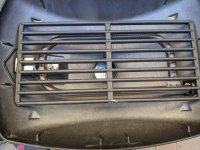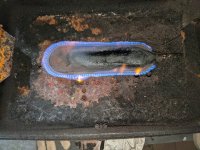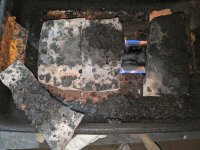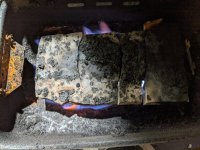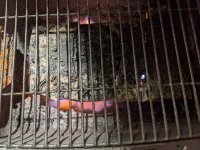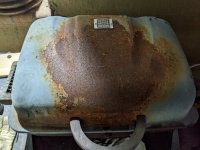Hi Q gurus, I was wondering if installing flavorizer bars in my Q 200 is worth it or even makes sense. I wonder if anyone has tried it and I also wonder if Weber ever not thought about it. But, with the very limited internal space, it may not have been a viable option for them. I am kind of guessing the bowl, although not above the flames, may serve the purpose since the space is so compact inside but not exactly the same. There is an Youtube video on Q with a set of flavorizer bars (
) but the person does not explain where/how he got the parts and hot the mod turned out. So, what do you think?
You are using an out of date browser. It may not display this or other websites correctly.
You should upgrade or use an alternative browser.
You should upgrade or use an alternative browser.
Flavorizer bars for Q?
- Thread starter Joseph K
- Start date
Bruce
TVWBB 2-Star Olympian
Oh, I am sure the R&D department at Weber toyed with that idea. But IMO it is a rabbit hole.
If you look at that setup, the far right and left sides are unprotected so that is only a partial remedy. Another and bigger problem that I see is that your heat distribution would be dismal. The heat at grate level would be all over the place. The right and left sides of the grill would likely be super hot with uncovered burners on those ends along with heat traveling under the flavorizer bars and out each end. You would get very little heat on top of the flavorizer bars since the bars are so close to the grates which already have grease shields built into them.
No, nice idea, but I am sure Weber didn't miss anything in leaving Flavorizer bars out of the Q grills.
If you look at that setup, the far right and left sides are unprotected so that is only a partial remedy. Another and bigger problem that I see is that your heat distribution would be dismal. The heat at grate level would be all over the place. The right and left sides of the grill would likely be super hot with uncovered burners on those ends along with heat traveling under the flavorizer bars and out each end. You would get very little heat on top of the flavorizer bars since the bars are so close to the grates which already have grease shields built into them.
No, nice idea, but I am sure Weber didn't miss anything in leaving Flavorizer bars out of the Q grills.
Bruce, thanks for the insight. The kind of input I can only receive from TVWBB. Yeah, I see the uneven heat distribution problem. I also realize, as you said, the way Q grates are designed probably has something to do with the interactions with the burners and not having flavorizer bars in a very tight space.Oh, I am sure the R&D department at Weber toyed with that idea. But IMO it is a rabbit hole.
If you look at that setup, the far right and left sides are unprotected so that is only a partial remedy. Another and bigger problem that I see is that your heat distribution would be dismal. The heat at grate level would be all over the place. The right and left sides of the grill would likely be super hot with uncovered burners on those ends along with heat traveling under the flavorizer bars and out each end. You would get very little heat on top of the flavorizer bars since the bars are so close to the grates which already have grease shields built into them.
No, nice idea, but I am sure Weber didn't miss anything in leaving Flavorizer bars out of the Q grills.
Richard in NS
TVWBB Wizard
Plus, they work really well the way they are for direct grilling. If you want indirect, throw a pan or tinfoil on there with a rack on top and you are good to go. Looks like that mod is a lot of work for nothing.
Jon Tofte
TVWBB 1-Star Olympian
That would certainly help keep your burners cleaner, but I agree very much with what has been said in that the very direct grilling and the radiant heat of the thick cast iron grate are what make the Qs such outstanding cookers. Sure, they need more frequent cleaning, but use a small plastic scraper and you can do that in a couple minutes - no flavorizer bars to remove!
LMichaels
TVWBB 2-Star Olympian
And fwiw if you want easier cleaning but still getting the great heating performance of the thick cast iron, the thick SS ones people like Bruce and I have bought. They perform every bit as well as OEM cast iron EXCEPT if you want grill marks that look painted on. They do give you an overall wonderful sear, just no lines. For those times I think I might want a steak looking like someone took a magic marker to it I kept my cast iron ones. But honestly have never put them back on. They are hanging in my garage
Thank your for all the input. Well, with the unanimous verdict from the panel, I am tossing the idea of having flavorizer bars for now. The reason I was looking for flavorizer bars in my Q 200 was for more flavors. Thought with flavorizer bars, Q would produce even better end results. But, as Jon put it, my Q was doing excellent cooking already and as Richard put it, all the work for nothing useful in the end. Yes, Larry, I've been looking at those Stanbroil SS grates and they are at the top of my wish list. Thanks, all.
Michael Smotch
TVWBB Fan
Which ss grates are you using with Q? Looking to upgradeAnd fwiw if you want easier cleaning but still getting the great heating performance of the thick cast iron, the thick SS ones people like Bruce and I have bought. They perform every bit as well as OEM cast iron EXCEPT if you want grill marks that look painted on. They do give you an overall wonderful sear, just no lines. For those times I think I might want a steak looking like someone took a magic marker to it I kept my cast iron ones. But honestly have never put them back on. They are hanging in my garage
LMichaels
TVWBB 2-Star Olympian
They look like these https://www.ebay.com/itm/1532890658...var=453169695213&_trksid=p2060353.m1438.l2649 but were only about $50. Sadly Stanbroil doesn't make them anymore choosing instead to go with the (inferior for this type of grill) rod grates. I guess since it's MUCH cheaper to make them from rods rather than solid laser cut stainless they went that route. Rod type will be easier to clean and such but will never work and perform the way that Weber engineered the grill to work
Michael Smotch
TVWBB Fan
Thanks. Yeah couldn't find them from stanbroil. Stick to cleaning the cast iron grates , oh well
George Yanase
New member
This is the modification I did for my new Q1200. I knew it needed some sort of heat dispersion method. I was thinking of a cheap stainless steel grate that I could cut down and put lava rocks on it to spread the flames. A flavorizer tent wasn't going to work with the burner. The distance between the burners is too great. I wanted a better spread. I measured the distance from the burner to the top grates. I decided to use perforated ceramic tiles instead of lava rocks. Now I had to decide on the grate. I knew the steel grate would rust out pretty quickly being exposed to burner flame. I found some cast-iron enamel gates. 11" x 15" . Solid and heavy like the grates that came with the Q1200. I used an angle grinder to cut it down width-wise. Cut off five sections to make it fit inside the box and not impinge on the burner. Lengthwise it is supported at the ends by the inner box. Two rows of tiles fit perfectly. My surprise. This is the result.
Bruce
TVWBB 2-Star Olympian
Could you show the grate under the ceramic blocks?
That is a really interesting mod and hope to hear how it performs for you. I had never thought of doing anything like that to a Q grill.
I wonder if you could drop a Q1000 grate into a Q2000 and if it would sit on top of the burners or suspend above it. Maybe a Q2000 grate in a Q3000? This idea opens up some real possibilities.
That is a really interesting mod and hope to hear how it performs for you. I had never thought of doing anything like that to a Q grill.
I wonder if you could drop a Q1000 grate into a Q2000 and if it would sit on top of the burners or suspend above it. Maybe a Q2000 grate in a Q3000? This idea opens up some real possibilities.
George Yanase
New member
4th picture down. There is an issue with the temperature which is due to the pressure and the orifice. As it is, I got good cook on boneless chicken and sausages but the ribeye came out medium instead of medium-rare having to stay on the grates longer as the temp never got past 375. And I had to preheat for 20 minutes to get it that high. There is a modification I did to increase the temp and flame size without purchasing parts. I'll post that as well. As for modifying a Q2000, You may have to do some measuring as the interior dimensions are different. But getting a grate that has the L x W dimensions that you can adjust by cutting to fit should be doable. Measure your grate from corner to corner, excluding the rounded edges. Then cut to fit width-wise. It came as a two-pack so I can replace the grate in the future if it starts to rust away. Hope that helps.Could you show the grate under the ceramic blocks?
That is a really interesting mod and hope to hear how it performs for you. I had never thought of doing anything like that to a Q grill.
I wonder if you could drop a Q1000 grate into a Q2000 and if it would sit on top of the burners or suspend above it. Maybe a Q2000 grate in a Q3000? This idea opens up some real possibilities.
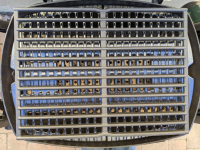
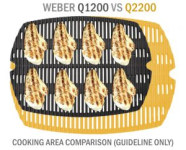
Attachments
Last edited:
George Yanase
New member
I'm the OP, I am curious as to what it is that you think that I won't like.I'm staying outta this one cause no one's gonna like what I am thinking
Joe Anshien
TVWBB Honor Circle
I like the concept but I think there is just too much thermal mass for that Q to heat up. You are going to use a LOT of fuel to get the grill up to temp. On a low and slow cook it may be worthwhile.
LMichaels
TVWBB 2-Star Olympian
I think you're going down a slippery slope and ruining a perfectly well engineered grill. At the least. At the worst you're tuning into something that could actually verge on unsafeI'm the OP, I am curious as to what it is that you think that I won't like.
George Yanase
New member
Interesting. I have 30+ years as an appliance technician (retired) working on home and commercial appliances. I worked on restaurant ranges, griddles, hot plate, char-broilers, pizza ovens. Safety-wise I'm pretty sure I understand what safe is. The cast iron grate I installed is not in contact with the burner. The ceramic tiles have multiple openings that allow the free flow of heat, by radiant and convection. The flames are not being smothered, there is space between the tiles and the top grates. I now have a much more even spread of heat. Perhaps you know how a flat griddle works? A thick flat steel plate is heated directly from below by several stainless steel gas burners transferring the heat of the flames to the griddle. So again, I'm confused why you think this would be a safety issue when many people here on this forum have already made modifications including replacing the oem regulator with an aftermarket adjustable regulator in order to increase the gas pressure due to the low flame that is present on the Q series grills. This is how the tiles look after the first cook. I still have and use my old rusty Master Forge 10+ years old. The burner is still good. Puts out 2x more heat than the Q. I used garden flagstone as radiant flame spreaders on top of the burner so I wouldn't burn everything. To address the low flame on the Q, I modified it by reaming out the fixed orifice thereby increasing the gas flow to the burner without replacing anything. Works fine, flames are now larger and producing more heat, now I can hit 520 degrees after 20 minutes. Where before I couldn't heat past 375 degrees no matter how long I left it on. 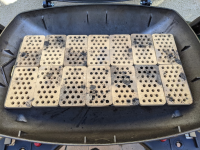

Attachments

